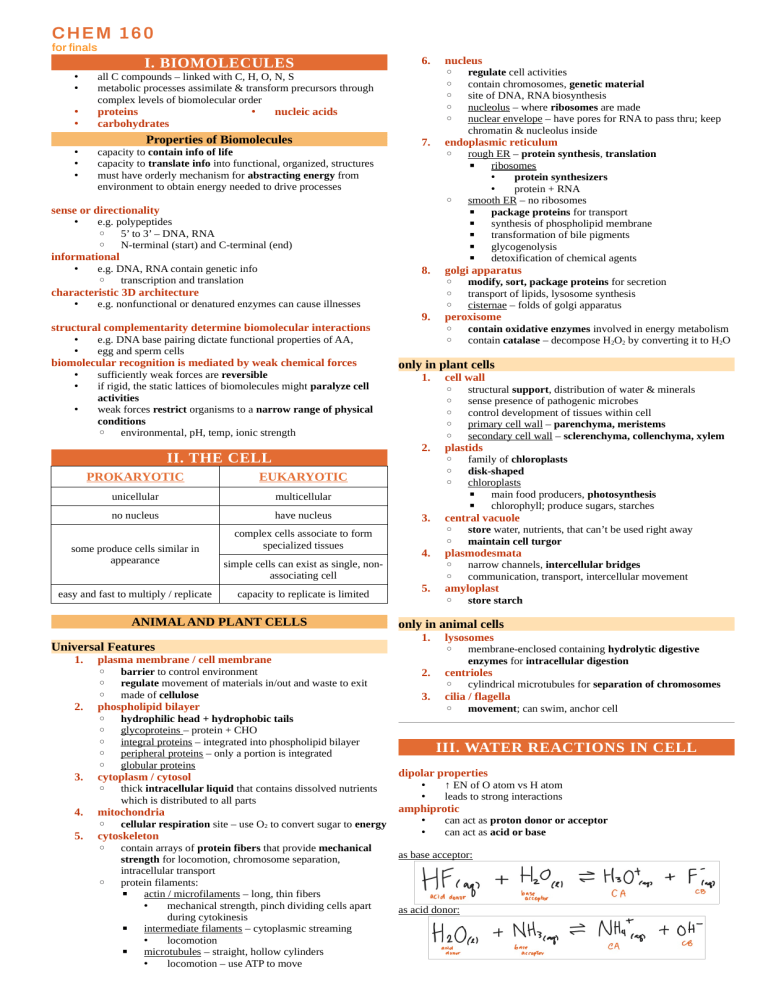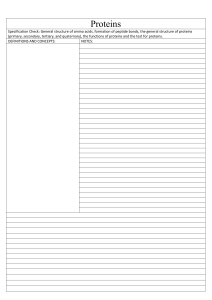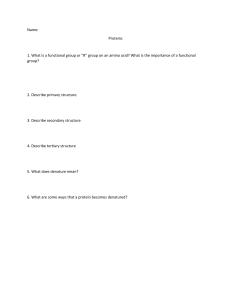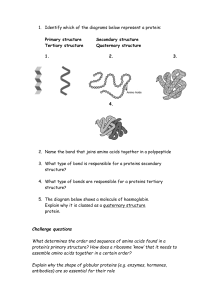
CHEM 160 for finals I. BIOMOLECULES • • all C compounds – linked with C, H, O, N, S metabolic processes assimilate & transform precursors through complex levels of biomolecular order • • proteins carbohydrates • • • capacity to contain info of life capacity to translate info into functional, organized, structures must have orderly mechanism for abstracting energy from environment to obtain energy needed to drive processes • 6. ◦ ◦ ◦ ◦ ◦ nucleic acids Properties of Biomolecules 7. ◦ e.g. polypeptides ◦ 5’ to 3’ – DNA, RNA ◦ N-terminal (start) and C-terminal (end) informational • e.g. DNA, RNA contain genetic info ◦ transcription and translation 8. characteristic 3D architecture • e.g. nonfunctional or denatured enzymes can cause illnesses structural complementarity determine biomolecular interactions • • e.g. DNA base pairing dictate functional properties of AA, egg and sperm cells • • sufficiently weak forces are reversible if rigid, the static lattices of biomolecules might paralyze cell activities weak forces restrict organisms to a narrow range of physical conditions ◦ environmental, pH, temp, ionic strength biomolecular recognition is mediated by weak chemical forces • PROKARYOTIC EUKARYOTIC unicellular multicellular no nucleus have nucleus easy and fast to multiply / replicate complex cells associate to form specialized tissues simple cells can exist as single, nonassociating cell capacity to replicate is limited ANIMAL AND PLANT CELLS Universal Features 1. 2. 3. 4. 5. 1. 3. 4. 5. barrier to control environment regulate movement of materials in/out and waste to exit made of cellulose ◦ ◦ ◦ ◦ ◦ hydrophilic head + hydrophobic tails glycoproteins – protein + CHO integral proteins – integrated into phospholipid bilayer peripheral proteins – only a portion is integrated globular proteins ◦ thick intracellular liquid that contains dissolved nutrients which is distributed to all parts phospholipid bilayer cytoplasm / cytosol mitochondria ◦ cellular respiration site – use O2 to convert sugar to energy ◦ contain arrays of protein fibers that provide mechanical strength for locomotion, chromosome separation, intracellular transport protein filaments: ▪ actin / microfilaments – long, thin fibers • mechanical strength, pinch dividing cells apart during cytokinesis ▪ intermediate filaments – cytoplasmic streaming • locomotion ▪ microtubules – straight, hollow cylinders • locomotion – use ATP to move cytoskeleton ◦ golgi apparatus ◦ ◦ ◦ modify, sort, package proteins for secretion transport of lipids, lysosome synthesis cisternae – folds of golgi apparatus ◦ ◦ contain oxidative enzymes involved in energy metabolism contain catalase – decompose H2O2 by converting it to H2O peroxisome cell wall ◦ ◦ ◦ ◦ ◦ structural support, distribution of water & minerals sense presence of pathogenic microbes control development of tissues within cell primary cell wall – parenchyma, meristems secondary cell wall – sclerenchyma, collenchyma, xylem ◦ ◦ ◦ family of chloroplasts disk-shaped chloroplasts ▪ main food producers, photosynthesis ▪ chlorophyll; produce sugars, starches plastids central vacuole ◦ ◦ store water, nutrients, that can’t be used right away maintain cell turgor ◦ ◦ narrow channels, intercellular bridges communication, transport, intercellular movement ◦ store starch plasmodesmata amyloplast only in animal cells 1. lysosomes ◦ plasma membrane / cell membrane ◦ ◦ ◦ rough ER – protein synthesis, translation ▪ ribosomes • protein synthesizers • protein + RNA smooth ER – no ribosomes ▪ package proteins for transport ▪ synthesis of phospholipid membrane ▪ transformation of bile pigments ▪ glycogenolysis ▪ detoxification of chemical agents only in plant cells 2. II. THE CELL some produce cells similar in appearance 9. regulate cell activities contain chromosomes, genetic material site of DNA, RNA biosynthesis nucleolus – where ribosomes are made nuclear envelope – have pores for RNA to pass thru; keep chromatin & nucleolus inside endoplasmic reticulum ◦ sense or directionality • nucleus 2. 3. membrane-enclosed containing hydrolytic digestive enzymes for intracellular digestion centrioles ◦ cylindrical microtubules for separation of chromosomes ◦ movement; can swim, anchor cell cilia / flagella III. WATER REACTIONS IN CELL dipolar properties • • ↑ EN of O atom vs H atom leads to strong interactions • • can act as proton donor or acceptor can act as acid or base amphiprotic as base acceptor: as acid donor: STRONG ACIDS & BASES BUFFERS • solution that resist drastic changes in pH when small amounts of acids and bases are added based on biological functions IV. PROTEINS • • • polypeptides, most abundant macromolecules MW ≥ 10,000 Daltons classified based on: ◦ shape, solubility, behavior, functions, 3D structures 1. yield only amino acids or its derivatives when hydrolyzed 3. Simple Proteins • subclass solubility properties examples albumin (+) water • heat: coagulated • deficient in glycine • albumin (egg) • serum albumin (blood) • lactalbumin (milk) globulin (+) dilute salt (~) water • heat: coagulated • contain glycine • ovoglobulin (egg yolk) • serum globulin (blood) • myosin (muscle) glutelin (-) neutral solvents (+) dilute sol’n of acids and bases • occur only in plants • glutenin (wheat) • oryzenin (rice) scleroproteins (-) most albuminoids solvents • entirely animal proteins • exoskeletal structures • fibrous tissues • cartilage, bones • keratin (hair, nails) • elastin (ligaments) • collagen (bones) • fibroin (silk) prolamin • plant protein usually in seeds • yield proline • deficient in lysine • zein (corn) • hordein (barley) • gliadin (wheat) (+) 70-80% alcohol (-) water, neutral solvents 2. 4. 5. 6. 7. 8. PROTEIN ORGANIZATION Primary Structure • • • • • • • • Conjugated Proteins simple proteins combined with non-protein substances subclass nucleoprotein group nucleic acid occurrence • plant, animal tissues • nuclear materials e.g. yeasts, sperm examples linear amino acid sequence stabilized by covalent peptide bonds structural integrity, proper folding determine shape, conformation ◦ conformation determine function Secondary Structure 1. • biochemical catalysts – enzymes ◦ speed up biochemical reactions defense ◦ first line of defense against bacteria, viruses ◦ antibodies, immunoglobulins, fibrinogen, thrombin transport ◦ hemoglobin – transfer of oxygen ◦ transferrin- vertebrate blood regulatory ◦ control certain metabolic processes ◦ insulin – type 1 diabetes ◦ glucagon – release glucose structural ◦ mechanical support ◦ keratin, collagen nutrient ◦ source of amino acids ◦ ovalbumin, casein storage ◦ myoglobin – store O2 in muscles contractive ◦ ability to contract, change shape, move ◦ actin, myosin, elastin 2. • nucleohistone • nucleoprotamine arrangement in backbone of protein regular repetitive conformation 1 peptide chain only dictated by maximum H-bonding involving carbonyl group of one peptide bond and amino group of another α-helix ◦ right-handed helix with 3.6 amino acids per turn ◦ stabilized by H-bonding between peptide bonds ◦ fibrous proteins – in hair, feathers, skin, collagen β-pleated sheets ◦ AA with small compact R groups ◦ can be parallel or anti-parallel ◦ interchain H-bonding among peptide bonds ◦ in fingernails, animal horns Tertiary Structure glycoprotein carbohydrates • membrane proteins immunoglobulin G • antibodies, other secreted proteins lipoproteins lipids • • • 3D structure resulting from R-group interactions ◦ H-bond, disulfide bond, hydrophobic & electrostatic interactions coils may be looped, twisted, folded fibrous or globular • phospholipid protein complexes • in plants, animals, bacteria, viruses • milk, blood, cell membrane, chloroplasts β-lipoprotein (blood) phosphoprotein phosphate groups - • casein (milk) • vitellin (egg) hemoproteins - • hemoglobin • cytochrome • catalase • peroxidase fibrous proteins: collagen flavoproteins heme (iron porphyrin) hemoglobin • • • • flavin nucleotides - succinate dehydrogenase metalloproteins • metal ions • Fe, Cu - • ferritin • plastocyanin • • • • tetrahedral 4 heme groups surrounded by globin group heme – composed of porphyrin rings ◦ 4 iron atom each, binds O2 globin – 2 linked pairs of polypeptide chains ◦ 2 alpha chains, 2 beta chains 2 FORMS: ◦ oxygenated – bright red; oxyhemoglobin ◦ deoxygenated – purplish blue; deoxyhemoglobin extended polypeptide chains arranged along an axis physically tough; serve structural functions (-) water, dilute salt sol’n type I – densely packed fibers; skin, bones, cartilage, teeth type II – loosely packed fibers; elastic cartilage, cushion joints type III – muscles, organs, arteries type IV – filtration; in layers of skin Quaternary Structure • • • found only in oligomer proteins with 2 or more polypeptide chains formed by noncovalent association of tertiary strcutures common among globular proteins Native structure • • the primary, secondary, and tertiary structures of a protein provides certain identifying properties ◦ biological, enzymatic, solubility, reactivity, MW, size • • • any change in native structure brought about by disruption of forces/chemical bonds in tertiary or quaternary structures reversible or irreversible • • • • • become insoluble, with ppt ↑ viscosity ↓ surface tension ↑ ionizable easier digested inactivation / loss of biological activity Denaturation Effects of denaturation Physical Agents heat UV rad reversible cooking – casein irreversible cooking – egg albumin increase in kinetic energy of molecules; disrupt interactions sunburn agitation hydrostatic pressure egg white whipping, milk churning ↓ volume ↑ pressure Chemical Agents acids and bases disrupt ionic interactions change in pH ↓ pH ↑ concentration of H ions more groups are protonated/attracted organic solvents disrupt H-bonds • alcohol – 70% para not very volatile pero makakapatay pa rin salt solution disrupt ionic interactions, disulfide bridges detergents hydrophobic; disrupt V. AMINO ACIDS • • • • polar, strong IMF – dipole-dipole; H-bonding high MP amphoteric substance – can react with acid or base acidity and basicity lower than expected Structure • • • • • • tetrahedral amino group – (basic) functional group of amines carboxyl group – (acidic) functional group of carboxylic acid ◦ H / amino group / carboxyl group / R side chain amphoteric ◦ internal acid-base reaction ◦ high MP and solubility of AA ◦ charged → ionic reaction (difficult to break bonds) chiral execept for glycine – 4 different groups attached to α-C all AA derived from natural proteins are of L configuration Polar Non-polar alkyl chain R groups R groups that can H-bond with water cyclic structure aromatic / -S Essential Amino Acids • • not synthesized by body or synthesize in very small amount PVTMATHILL phenylalanine Phe | F dopamine valine Val | V mental vigor threonine Thr | T signals methionine Met | M decrease DNA damage arginine Arg | R lung efficiency; essential to children tryptophan Trp | W infant growth histidine His | H growth, tissue repair isoleucine Ile | I wound healing, hormone secretion leucine Leu | L prevent breakdown after trauma lysine Lys | K blocking agent, prevent colds alanine Ala | A energy source asparagine Asn | N non-toxic ammonia aspartic acid Asp | D synthesis of other AA cysteine Cys | C for chronic diseases glutamic acid Glu | E nervous system; excitatory glutamine Gln | Q urea formation glycine Gly | G manufacture hormone proline Pro | P repair skin serine Ser | S fat metabolism, muscle growth tyrosine Tyr | Y brain chemicals other amino acids Zwitterion • • both positive charge on 1 atom and negative on another atom ◦ neutral; net charge: 0 structure changes when pH of solution with AA changes Isoelectric point (IpH / pI) • • pH of solution at which the concentration of zwitterion is at its maximum average of pKa values Henderson-Hasselbach [ conjugatebase ] pH =pKa+log [ acid] VI. ENZYMES • • • • biological catalysts that speed up biological reactions give alternative route that gives lower activation energy highly specific for reactions and in substrate/reactants catalysis takes place at active site • • inorganic and nonprotein helpers that bind to active site for catalysis e.g. Fe, Cu, Zn • • organic molecules that act as cofactor e.g. NAD, FAD, CoA • protein part free of cofactor • complete functional active protein, with cofactor cofactors coenzymes apoenzyme holoenzyme Factors that affect enzyme-catalyzed reactions substrate concentration • • ↑ substrate concentration ↑ rate of reaction until plateu there is a maximum amount of substrate; no effect beyond • • optimal pH usually near 7.4 optimal temp usually 37 °C • • region that binds substrate and cofactors contain residues that directly participate in making and breaking of bonds substrates bound to enzyme by multiple weak interactions pH and temperature Active sites of enzymes • Models of enzyme action Lock-and-Key • complementary • change to fit 1. oxidoreductase Induced Fit 6 Classifications of Enzymes ◦ ◦ ◦ ◦ ◦ 2. transferase ◦ ◦ ◦ ◦ 3. ◦ ◦ ◦ catalyze addition/removal of a group to create a double bond dehydrase – removal of water decarboxylase – removal of CO2 deaminase – removal of NH3 isomerase ◦ ◦ ◦ ◦ ◦ 6. catalyze substrate hydrolysis reactions addition of water to bond cause bond breaking lipase - hydrolysis of ester linkages protease – hydrolysis of peptide linkages nuclease – hydrolysis of sugar-phosphate ester bonds carbohydrase – hydrolysis of glycosidic bonds phosphatase – hydrolysis of phosphate-ester bonds e.g. ▪ lipase in hydrolysis of TAGs: triacylglycerol + H2O → glycerol + 3 FA lyase ◦ 5. catalyze transfer of functional groups between 2 substrates transaminase – transfer amino group kinase – transfer phosphate group e.g. ▪ glucokinase: glucose + ATP → glucose 6-phosphate + ADP hydrolase ◦ ◦ ◦ ◦ ◦ ◦ ◦ ◦ 4. catalyze redox reactions oxidase – oxidation of substrate reductase – reduction of substrate dehydrogenase- oxidation by removal of hydrogen e.g. ▪ ethanol → acetaldehyde (oxidation) ▪ NAD+ → NADH + H catalyze conversion of substrate to another isomeric compound racemase – D to L, v.v mutase – structural isomers epimerase – conversion of epimer sugars e.g. ▪ phosphoglucomutase: glucose 1-phosphate → glucose 6-phosphate ligase ◦ ◦ ◦ ◦ catalyze bonding together of 2 substrates with ATP synthetase – form new bond between substrates carboxylase – form new bond between substrate and CO2 e.g. ▪ asparagine synthetase: aspartate + NH3 + ATP → asparagine + AMP + PPi Enzyme Kinetics Enzyme Inhibition • • enzyme activity can be inhibited by binding of specific small molecules and ions slowing or stopping normal catalytic function of enzyme Irreversible inhibition • • • dissociate very slowly from target enzyme tightly bound covalently or non-covalently e.g ◦ penicillin – (antibiotic) bind to transpeptidase (protein synthesis) ◦ aspirin – (anti-inflammation) inhibit formation of prostaglandins Reversible inhibition • rapid dissociation of enzyme inhibitor complex Types of reversible inhibition Competitive inhibition • • • diminish rate of catalysis by reducing enzyme proportion bound to substrate compete for same active site ↑ Km : Vmax no effect Non-competitive inhibition • • • inhibitor and substrate bind simultaneously at different binding sites change shape of enzyme Km no effect : ↓ Vmax • • • require substrate-enzyme complex when ↑ substrate concentration ↓ Km : ↓ Vmax Uncompetitive inhibition COENZYMES* NAD+ / NADP+ • nicotinamide adenine dinucleotide • nicotinamide adenine dinucleotide phosphate nicotinamide ring • reactive part • accept H ion and 2 e- when substrate is oxidized NAD+ - e- acceptor in oxidation NADPH – (reduced form) for reductive biosynthesis FAD / FMN • flavin adenine dinucleotide • flavin mononucleotide isoalloxazine ring • • reactive part take up a proton and hydride ion + accept 2 e- Ubiquinone • • Coenzyme Q (CoQ) mobile electron carrier in ETC Cytochromes • • group of heme-containing proteins electron carrier in respiratory and photosynthetic ETC • required in many enzyme-catalyzed acetylations ◦ A: acetylation Coenzyme A (CoA)




